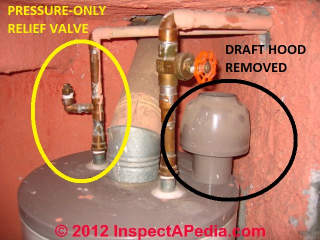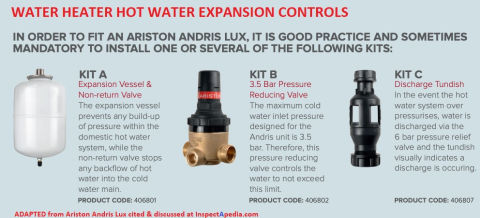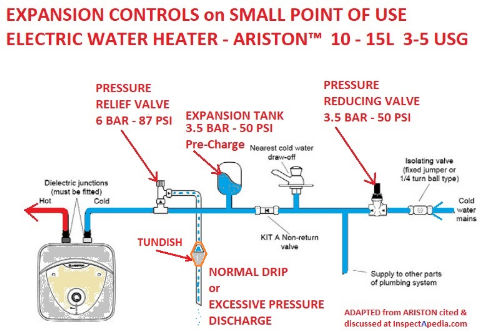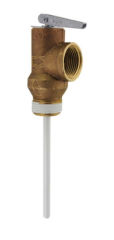 Pressure-Only Relief Valves on Water Heaters
Pressure-Only Relief Valves on Water Heaters
Are they safe on a calorifier, geyser, hot water cylinder
- POST a QUESTION or COMMENT about small electric point of use water heater pressure/temperature relief valves
When are pressure only relief valves safe on water heating equipment? Ever? What about water heater safety valves and companion safety devices on small electric point of use water heaters?
This article series explains temperature and pressure relief valves used on residential water heaters. We explain the function, inspection, and maintenance of temperature & pressure relief valves on water heaters used to produce hot water for washing and bathing.
InspectAPedia tolerates no conflicts of interest. We have no relationship with advertisers, products, or services discussed at this website.
- Daniel Friedman, Publisher/Editor/Author - See WHO ARE WE?
Pressure-Only Water Heater Relief Valves & Safety Devices
 Here we illustrate a "pressure-only" type relief valve installed on an older gas-fired residential water heater. This installation has two innate safety hazards:
Here we illustrate a "pressure-only" type relief valve installed on an older gas-fired residential water heater. This installation has two innate safety hazards:
Watch out: The safety device shown in this photo responds only to over-pressure, not to excessive temperature in the water heater
[Click to enlarge any image]
This pressure relief valve is located "remote" from the water heater tank itself, on the hot water supply pipe.
In a remote location, even if the valve were one that would also respond to temperature (this one is not), by moving it off of the hot water tank itself we delay its response and reduce its effectiveness as a safety device.
For conventional tank-type water heaters larger than 15L (5 USG), regardless of fuel, the hot water tank must be protected against rupture and a potentially fatal BLEVE (explosion) by mounting a properly rated relief valve on the water heater tank itself.
On a typical residential water heater, that means proper installation of a relief valve that responds to either or both over-pressure and excessive hot water temperature. For that circumstance, water heater manufacturers, building codes, and independent standards require that a temperature and pressure relief valve be installed on the water heater - a T&P Relief Valve.
...
Reader Comments, Questions & Answers About The Article Above
Below you will find questions and answers previously posted on this page at its page bottom reader comment box.
Reader Q&A - also see RECOMMENDED ARTICLES & FAQs
Question: what's wrong with a pressure-only relief valve on a water heater?
Hi, you mention in the article RELIEF VALVE, WATER HEATER that a pressure relief valve on its own is not sufficient to prevent a water heater from exploding but I cannot find any explanation for this.
Surely even without temperature relief a pressure relief valve would be far better than nothing?
Regards
This Q&A were posted originally
Moderator reply:
Tim
I did not think that I had said set a pressure relief valve cannot prevent a water heater explosion. I review the article and not found that statement but I'll look again. Perhaps I've Miss spoken or perhaps you miss understood or I've been confusing about a statement in the article.
The Ariston point of use water heater safety devices shown here are not the only possible installation configuration for this type of water heater, but they illustrate three additional safety devices that improve the safety of a 2-5 gallon POU electric water heater protected by a pressure-only relief valve.
Pressure relief valve needs to be sized big enough to discharge energy in the form of hot water at a rate that is not exceeded by the burner putting energy into the water heater. If the relief valve is blocked, modified, constricted, or damaged in some way then an explosion could still occur.
Watch out: a damaged, improperly-selected model, or modified pressure/temperature relief valve is dangerous and could lead to a serious BLEVE explosion should the water heater later overheat.
Here's an excerpt from the BLEVE article
The model of relief valve installed should meet the specifications of the water heater or heating boiler or other equipment on which it is installed.
Reader follow-up
Thank you for your response, and a very informative article. Apologies, the text I was referring to was on the following InspectAPedia page, possibly not written by you:
In that article under the heading WATER HEATER TPR VALVE INSTALL the author makes the following statement:
"Do not depend on a pressure-relief only valve (no temperature response) to protect a hot water heating system. Pressure relief alone can't prevent a water heater tank explosion.
See BLEVE EXPLOSIONS for details.
Pressure relief valves are only intended for protection of tanks that are not heated - such as a well water pressure tank or a cold water storage tank. Where a pressure-only relief valve is to be used it should be installed as close as possible to the equipment it's protecting."
I have noticed that on small (10 litre) water Heaters such as the Ariston Adrus Lux they do not have a T&P valve at all and allow this unit to be installed with a faucet on the hot water line so no venting is possible. I wondered why this is allowed in Italy and other countries.
Thanks again for your time and knowledge.
Moderator reply: pressure-only relief valves are manufacturer-specified on some small point-of-use electric water heaters
 Thanks Tim as your question helps us understand where we need to make information more clear or accurate.
Thanks Tim as your question helps us understand where we need to make information more clear or accurate.
The statements you quote - which are mine - are quite correct. It is important to notice the word "only" in the phrase
"pressure-relief only valve" and also the parenthetical note (no temperature response).
A relief valve that ONLY responds to PRESSURE may indeed be incapable of dumping energy fast enough to avoid a BLEVE explosion when such a valve is installed on a tank that is subject to BOTH HEAT AND PRESSURE, such as a conventional residential water heater (calorifier, geyser), or a hot water heating boiler (hydronic heat), or a steam boiler (steam heat).
Pressure-only relief valves are perfectly correct for use on tanks subjected to pressure only, such as a water supply pressure tank or well tank.
On some older residential oil, gas, electric residential-sized calorifiers or geysers or hot water heaters (for making domestic hot water for washing or bathing), as well as on some very small, modern, point-of-use water heaters we may see a "pressure-only" relief valve installed.
Watch out: on a conventional residential water heater (say a 30 to 50 gallon tank heated by oil, gas, or electricity), worse still, those pressure-only valves were often installed some distance away from the hot water heating tank itself, on a nearby cold or hot water pipe. Those valves, in that use, are in UNSAFE and they will be prohibited by plumbing codes in most jurisdictions.
But your example provides a different case, and an exception as we'll elaborate:
On a small water heater such as the Ariston Adrus Lux, the manufacturer's engineers may have decided that the heat input capacity of their heater is so small, and the volume of water in the tank so small as well, that a pressure-only relief valve is adequate. Those small electric water heaters are sold in the UK by Ariston (https://www.ariston.com/) and operate in the 1.5 to 3 KW range.
The company says "In the event the hot water system over pressurises, water is discharged via the 6 bar [87 psi] pressure relief valve and the tundish visually indicates a discharge is occuring".
That pressure may be so low and conservative that the company's engineers indeed opine that there is no consequential risk of a BLEVE.
Expanding on the safety of these small heaters when protected by a pressure-only relief valve, note the company's comment that in some jurisdictions additional safety devices may be required, such as an inlet pressure reducer that makes sure that the inlet pressure does not exceed 3.5 bar (50 psi)
In sum, from your example we can reasonably infer that a pressure-only relief valve may provide adequate BLEVE protection, where approved by local plumbing authorities and codes, for small water heating devices of limited volume, of limited energy input (1.5 to 3 KW), and where input pressure is also carefully limited (to 3.3 bar or 50 psi).
Contact: Ariston directly to ask where their product is accepted by local codes, apparently in many countries.
Customer Service: customer.service.uk@aristonthermo.com | 0333 240 8777
Sales: salesoffice@aristonthermo.com | 0333 240 6666
Note also the operating pressure of the point of use water heater relief valve: input pressure must be limited to 3.5 bar (50 psi), and the valve opens at 6 bar (87 psi)
In contrast a typical residential water heater pressure / temperature relief valve such as the Rheem Protech shown below responds at a higher range:
Temperature Relief: 210°F (99°C),
Pressure Relief Range: 75 to 150 psi (5.2 to 10.3 bar).
Plumbing codes that permit the use of a pressure-only relief valve typically will either limit the size of the heated water tank to 15L or less, or will require additional safety devices.
See this ANDRIS LUX WATER HEATER IO MANUAL [PDF] retrieved 2020/04/12, original source: Ariston, Op. Cit., www.ariston.com/uk/Electric_Water_Heaters/media/files/830_Andris%20Lux%20UK%20Manual%202017.pdf
Excerpts:
13. Do not tamper with the overpressure safety device, if supplied together with the appliance; trip it from time to time to ensure that it is not jammed and to remove any scale deposits. In countries which have enacted EN 1487, the appliance's intake pipe must be equipped with a safety device compliant with the said standard, calibrated to a maximum pressure of 0.7 MPa, including at least a cock, check valve, safety valve and hydraulic load cutout.
14. It is normal that water drip from the overpressure safety device and EN 1487 safety unit when the appliance is heating. For this reason one must install a drain, open to the air, with a continuously downwards sloping pipe, in an area not subject to subzero temperatures. Make sure to drain the appliance when it is out of service or in an area subject to subzero temperatures.
Building Regulations These are a statutory document and take priority over all other regulations and recommendations. The installation of an unvented hot water system of over 15 litres is classified as a “Controlled Service” and Regulation G3 applies. To meet the requirements of the regulation, installation of an unvented system should be undertaken by a “competent installer”. All installations of unvented hot water storage systems having a capacity of more than 15 litres should be notified to the relevant Local Authority by means of building notice or by the submission of full plans. It is important to note that it is a criminal offence to install an unvented hot water storage system over 15 litres without notifying the Local Authority
The model 30L is covered under the Building Regulations and therefore it is not possible to accommodate the expansion water within the system pipe work and consequently a set of expansion controls must be installed.
- Ariston Thermo S.p.A., Viale Aristide Merloni, 45, 60044 Fabriano (AN), Tel. (+ 39) 0732 .6011 ariston.com
Is Dripping From a Water Heater Relief Valve Normal?
 Generally, no, not on a heating boiler nor on a typical residential water heater tank larger than 15L (5 USG), for the reasons we listed just above.
Generally, no, not on a heating boiler nor on a typical residential water heater tank larger than 15L (5 USG), for the reasons we listed just above.
However there is at least one exception: it may be "normal" to see dripping from the relief valve of certain small 2-5 gallon point of use electric water heaters.
Some small point-of-use water heaters, such as some of Ariston's Andris Lux point of use electric storage water heaters, include this statement in the water heater's IO Manual:
14. It is normal that water drip from the overpressure safety device and
EN 1487 safety unit when the appliance is heating.
For this reason
one must install a drain, open to the air, with a continuously
downwards sloping pipe, in an area not subject to subzero
temperatures.
Make sure to drain the appliance when it is out of
service or in an area subject to subzero temperatures. - Source: Ariston unvented water heater IO manual cited below.
Watch out: for safety, to recognize that a water heater relief valve is leaking, the installation of a tundish is important. See details
at TUNDISH used in PLUMBING
Watch out: As our we cited above, mineral salts left behind as hot water evaporates from the mouth of a pressure or temperature relief valve can completely clog the spring that is intended to allow the relief valve to open under excess (unsafe) pressure. Ariston recommends that the water heater shown here be protected from hard water (water high in mineral content).
- ANDRIS LUX WATER HEATER IO MANUAL [PDF] Ariston Thermo S.p.A. Viale Aristide Merloni, 45 60044 Fabriano (AN) Tel. (+ 39) 0732 .6011 ariston.com retrieved 2020/04/12, original source: Ariston, Op. Cit., https://www.ariston.com/uk/Electric_Water_Heaters/media/files/830_Andris%20Lux%20UK%20Manual%202017.pdf
Note: we recommend that for most conditions residential water pressure inside the building should not exceed 70 psi. We observe an increase of leaks and drips at faucets and toilets at higher building pressures as the pressure may exceed the design pressure of some plumbing fixtures.
See WATER PRESSURE REDUCER / REGULATOR.
Watch out: as we discuss above, dripping TP relief valves are unsafe. The hazard is that minerals in the water supply accumulate inside the valve during the passage of hot water through the valve assembly.
That accumulation of scale will eventually block operation of the relief valve, causing the relief valve to fail to operate properly if unsafe pressure or temperature occurs in the water heater in the future. The risk, ultimately, is a water heater tank or heating boiler explosion.
Safety Warning- a damaged, improperly-selected model, or modified pressure/temperature relief valve is dangerous and could lead to a serious BLEVE explosion should the water heater later overheat.
...
Continue reading at RELIEF VALVE, WATER HEATER - home, or select a topic from the closely-related articles below, or see the complete ARTICLE INDEX.
Or see these
Recommended Articles
- GAS WATER HEATER AUTOMATIC SHUTOFF - temperature operated gas supply shutoff for water heaters, Watts 210-5 series
- HOT WATER PRESSURE EXPANSION RATE - how much does water expand when you heat it?
- HOT WATER EXPANSION TANKS - how to cure the problem of leaks in heated hot water systems, calorifiers, water cylinders
- RELIEF VALVES - TP VALVES
- EXPANSION TANK WATERLOGGED, RELIEF VALVE LEAK
- RELIEF VALVE INSPECTION POINTS
- RELIEF VALVE DISCHARGE TUBE
- RELIEF VALVE LEAKS
- RELIEF VALVE LEAK DUE TO EXPANSION TANK
- RELIEF VALVE on STEAMBATH GENERATOR
- RELIEF VALVE, TP VALVE, BOILER
- RELIEF VALVE, TP VALVE, STEAM BOILER
- RELIEF VALVE, TP VALVE TEST
- RELIEF VALVE, WATER HEATER
- RELIEF VALVE, WATER TANK
- THERMAL EXPANSION TPR VALVE LEAKS
- TUNDISH used in PLUMBING
- RELIEF VALVE, WATER HEATER - home
- WATER HEATER TPR VALVE REQUIRED
- WATER HEATER TPR VALVE INSTALL
- WATER HEATER TPR VALVE LEAK DIAGNOSIS
- WATER HEATER TPR VALVE SIZE
- WATER HEATER TPR VALVE EXPLOSIONS
- WATER HEATER TPR VALVE for WATER HEATER DRAINING
- WATER HEATER TPR VALVE TEST
- WATER HEATER TPR VALVE TEST SCHEDULE
- WATER HEATER SAFETY DEVICES, OTHER
- WATER HEATER PRESSURE-ONLY RELIEF VALVES
- WATER HEATER SAFETY
- WATER HEATER TEMPERATURE ADJUSTMENT CONTROLS
Suggested citation for this web page
WATER HEATER PRESSURE-ONLY RELIEF VALVES at InspectApedia.com - online encyclopedia of building & environmental inspection, testing, diagnosis, repair, & problem prevention advice.
Or see this
INDEX to RELATED ARTICLES: ARTICLE INDEX to T&P RELIEF VALVES
Or use the SEARCH BOX found below to Ask a Question or Search InspectApedia
Or see
INDEX to RELATED ARTICLES: ARTICLE INDEX to PLUMBING SYSTEMS
Or use the SEARCH BOX found below to Ask a Question or Search InspectApedia
Ask a Question or Search InspectApedia
Try the search box just below, or if you prefer, post a question or comment in the Comments box below and we will respond promptly.
Search the InspectApedia website
Note: appearance of your Comment below may be delayed: if your comment contains an image, photograph, web link, or text that looks to the software as if it might be a web link, your posting will appear after it has been approved by a moderator. Apologies for the delay.
Only one image can be added per comment but you can post as many comments, and therefore images, as you like.
You will not receive a notification when a response to your question has been posted.
Please bookmark this page to make it easy for you to check back for our response.
IF above you see "Comment Form is loading comments..." then COMMENT BOX - countable.ca / bawkbox.com IS NOT WORKING.
In any case you are welcome to send an email directly to us at InspectApedia.com at editor@inspectApedia.com
We'll reply to you directly. Please help us help you by noting, in your email, the URL of the InspectApedia page where you wanted to comment.
Citations & References
In addition to any citations in the article above, a full list is available on request.
- [3] Pounds of lime deposited vs. temperature and hot water usage: see Purdue Bulletin #74 (also provided by A.O. Smith in the article below). Purdue's chart shows the number of pounds of lime deposited per year as a function of the water usage in gallons per day, with an assumed 10 grains of water hardness.
- [4] "When, Why, and How to Remove Water Scale from Tank Type Glass-Lined Water Heaters (for non glass-lined tanks, consult water heater manufacturer)" PDF provided by A.O. Smith Water Products Company - hotwater.com/lit/training/4800r9.pdf 800-433-2545 - 01/07/2009.
- [5] A.O. Smith's Form No. 4800 Rev. 8 Why? When? & How? /UN•LIME Specific De liming Instructions for use with Up-N-Down Transfer Kit for Tank Type Heaters. (Normally supplied in UN-LIME shipping cartons), Supersedes Form Nos. 4800 Rev. 7 and 4813-100.
- [6] A.O. Smith's Form No. 4778* All about Deliming Coil-Type/Tube-Type Commercial Water Heaters and Hydronic Boilers *Normally supplied when ordering Part No. 4930 Motorized Deliming Pump Kit
- [7] Building Owner Water Heater Safety Notice [PDF] Building Department, City of Colleyville TX, web search 09/24/2010, original source: http://www.colleyville.com/dmdocuments/Building%20
Owner%20Water%20Heater%20Safety%20Notice%203-6-102.pdf
Quoting:
Water heater safety is imperative to the occupants of a building or structure. If improperly installed, water heaters can be detrimental to the structure, as well as being potentially fatal to its occupants. The proper installation of a water heater is so important that according to Texas State Law all water heater installations must be inspected by a state licensed plumbing inspector. - [8] Rheem Electric Water Heater "Owners Guide and Installation Instructions", (Australian models) rheem.com.au/images/pdf/owners_dom-elec_121996C_0707.pdf
- [9] Watts, 815 Chestnut Street, North Andover, MA, USA 01845-6098, http://www.watts.com web search 09/18/2010 original source: http://www.watts.com/pages/learnAbout/reducingValves.asp?catId=64
- [11] "Four hurt as water heater explodes", Elaine Porterfield, Paul Shukovsky, Lewis Kamb, Seattle Post Intelligencer, 28 July 2001, web search 25 Sept 2010, original source: http://www.seattlepi.com/local/33094_boom28.shtml
Quoting from the original news article:
The powerful blast occurred at 10:23 a.m. at Plaza Zacatecas -- a small strip mall that includes four Mexican American-run businesses: a video store, a butcher shop, a Mexican restaurant and a shop that sold clothing and other items. ... The steam-powered tank hurtled across the busy intersection at First Avenue South and South 152nd Street -- over at least six lanes of traffic -- before landing more than 439 feet away in the parking lot of a Pizza Hut. ... The tank then tumbled another 25 feet before coming to rest. Four people were injured in the blast. Three were treated and released from a local hospital, but one woman was admitted to Harborview Medical Center with second-degree burns to her arm. - [12]
Water heater rocket myth: Mythbusters water heater explosion video produced ihn 2007, web search Sept 25 2010, original source:
http://www.youtube.com/watch?v=JmJoyuUJj2Q
Website: http://dsc.discovery.com/tv/mythbusters/
Quoting from Mythbusters: (Discovery Communications,
In small scale testing, the Mythbusters started with a small six gallon water heater and disabled all of its safety features under the theory of poor installation or neglect. While the water heater eventually ruptured, it did not explode like a rocket. The Mythbusters then upgraded to larger thirty gallon water heater which exploded with significantly greater force, sending the water heater several hundred feet into the air. In order to confirm the stated myth, the Mythbusters obtained a full size fifty two gallon water heater and built a shack around it with a roof that followed standard California building codes. The water heater eventually exploded, shooting through the roof five hundred feet into the air and disintegrating the shack. In light of these results, and the fact that there is documented evidence corroborating the myth, the Mythbusters deemed it confirmed. - [13]
Water heater video #2, Mythbusters exploding water heater demonstration, a 50 gallon water tank explosion
http://www.youtube.com/watch?v=0rXwcDkobUY&feature=related
http://www.waterheaterblast.com/
Because of built in safety devices most water heaters safely operate day in, day out without any major problems. But don't let the excellent safety record of water heaters lull you into forgetting about the explosive potential of these marvels of convenience. When a water heater explodes, it releases a tremendous blast force which can easily demolish a building.
Randall Hilton and crew, with help from the Service Roundtable has prepared this video of a water heater explosion as a demonstration of the explosive power of a simple water heater. The hot water tank explodes using the steam pressure that any water heater can generate when the thermostat and temperature pressure relief valve (T&P valve or PT valve) malfunction. We were impressed by how far the tank flew after the water heater exploded. Click on the links below to view the video. Then, visit the Q&A page for warning signs as well as simple steps which can help you prevent your own water heater from exploding. - Carbon Monoxide Gas Toxicity, exposure limits, poisoning symptoms, and inspecting buildings for CO hazards
- In addition to citations & references found in this article, see the research citations given at the end of the related articles found at our suggested
CONTINUE READING or RECOMMENDED ARTICLES.
- Carson, Dunlop & Associates Ltd., 120 Carlton Street Suite 407, Toronto ON M5A 4K2. Tel: (416) 964-9415 1-800-268-7070 Email: info@carsondunlop.com. Alan Carson is a past president of ASHI, the American Society of Home Inspectors.
Thanks to Alan Carson and Bob Dunlop, for permission for InspectAPedia to use text excerpts from The HOME REFERENCE BOOK - the Encyclopedia of Homes and to use illustrations from The ILLUSTRATED HOME .
Carson Dunlop Associates provides extensive home inspection education and report writing material. In gratitude we provide links to tsome Carson Dunlop Associates products and services.


